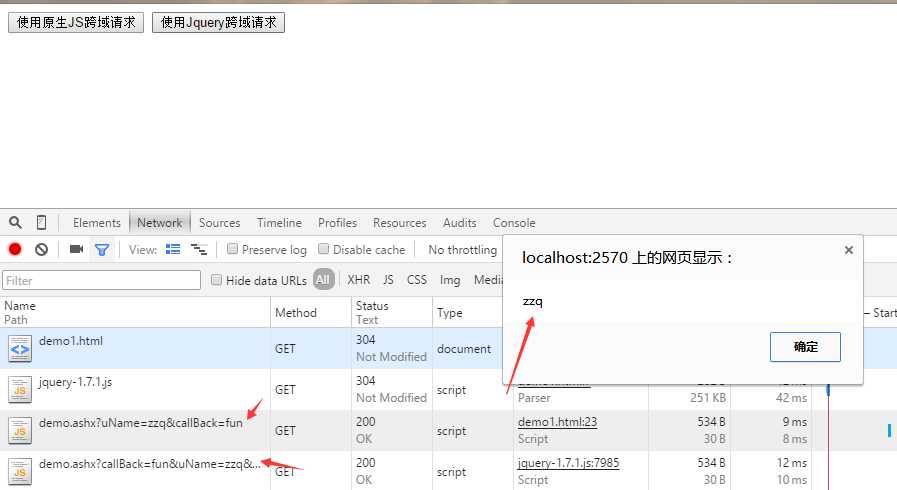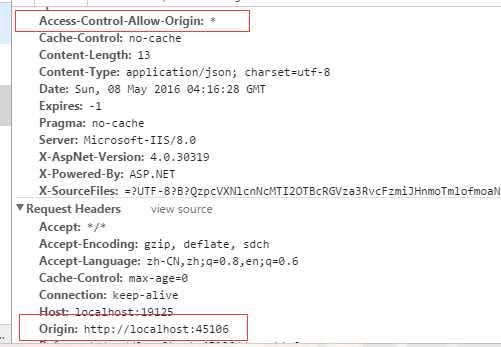标签:
我们知道ajax不能跨域访问,但是有时我们确实需要跨域访问获取数据,所以JSONP就此诞生了,其本质使用的是Script标签,除JSONP以外还有另外实现跨域方式
一、手动实现JSONP跨域
1、首先创建一个Web项目,在这里我使用一般处理程序
1 public class Demo : IHttpHandler
2 {
3 public void ProcessRequest(HttpContext context)
4 {
5 //接收参数
6 string callBack = context.Request["callBack"];
7 string uName = context.Request["uName"];
8 string data = "({\"name\":\"" + uName + "\",\"age\":\"23\"})";
9 string josnStr = callBack + data;
10 context.Response.Write(josnStr);
11 }
12
13 public bool IsReusable
14 {
15 get
16 {
17 return false;
18 }
19 }
20 }
2、创建一个新Web项目并新建html文件
1 <!DOCTYPE html>
2 <html xmlns="http://www.w3.org/1999/xhtml">
3 <head>
4 <meta http-equiv="Content-Type" content="text/html; charset=utf-8" />
5 <title>手动实现JSONP实现跨域请求Demo</title>
6 <!--引用jquery-->
7 <script src="/jquery-1.7.1.js"></script>
8 <script type="text/javascript">
9 var urlPrefix = "http://localhost:2571";
10 //js跨域请求中的回调函数
11 function fun(data) {
12 for (var i in data) {
13 alert(data[i]);
14 }
15 }
16 //js跨域请求
17 function jsRequest() {
18 var script = document.createElement("script");
19 script.setAttribute("id", "script1");
20 script.setAttribute("type", "text/javascript");
21 script.setAttribute("src", urlPrefix + "/demo.ashx?uName=zzq&callBack=fun");
22 //添加到body之后
23 document.documentElement.appendChild(script);
24 //使用完后移除
25 $("#script1").remove();
26 }
27
28 //jq跨域请求
29 function jqRequest() {
30 $.ajax(
31 {
32 url: urlPrefix + "/demo.ashx",
33 type: "get",
34 data: { uName: "zzq" },
35 dataType: "jsonp", //指定Jq发送jsonp请求
36 jsonpCallback: "fun", //指定回调函数,没有此项可以直接在success中写回调
37 jsonp: ‘callBack‘ //默认callback
38 //success: function (data) {
39 // for (var i in data) {
40 // alert(data[i]);
41 // }
42 //}
43 });
44 }
45 </script>
46 </head>
47 <body>
48 <!--Js跨域请求和Jquery跨域请求都不支持post方式,jquery跨域其实就是JS跨域的封装-->
49 <input type="button" value="使用原生JS跨域请求" onclick="jsRequest()" />
50 <input type="button" value="使用Jquery跨域请求" onclick="jqRequest()" />
51 </body>
52 </html>
3、测试,将两个网站都打开,http://localhost:2571:填写第一步创建网站的地址


两个请求都是返回同样的信息
二、添加请求头实现跨域
1、同样是先创建一个Web项目,跟上面一样使用的是一般处理程序,*.ashx,这里我只贴出重要的部分
1 public void ProcessRequest(HttpContext context)
2 {
3 //接收参数
4 string uName = context.Request["uName"];
5 string data = "{\"name\":\"" + uName + "\",\"age\":\"23\"}";
6 //只需在服务端添加以下两句
7 context.Response.AddHeader("Access-Control-Allow-Origin", "*");
8 //跨域可以请求的方式
9 context.Response.AddHeader("Access-Control-Allow-Methods", "POST,GET");
10 context.Response.Write(data);
11 }
2、创建一个新Web项目并新建html文件
1 <!DOCTYPE html>
2 <html xmlns="http://www.w3.org/1999/xhtml">
3 <head>
4 <meta http-equiv="Content-Type" content="text/html; charset=utf-8" />
5 <title>添加请求头跨域访问Demo</title>
6 <script src="/jquery-1.7.1.js"></script>
7 <script type="text/javascript">
8 function crosRequest() {
9 $.post("http://localhost:2571/XHR2Demo.ashx", { uName: "zzq" }, function (data) {
10 for (var i in data) {
11 alert(data[i]);
12 }
13 }, "json")
14 }
15 </script>
16 </head>
17 <body>
18 <input type="button" value="添加请求头跨域访问" onclick="crosRequest()" />
19 </body>
20 </html>
3、最后就是测试,查看效果了

加了以下信息


三、CROS实现WebApi跨域
1、新建WebApi项目并通过NuGet下载程序包,搜索程序包【Microsoft.AspNet.WebApi.Cors】,一般我喜欢下载一个中文包,方便查看注释

2、在Global的Application_Start中加上如下代码
1 var cors = new EnableCorsAttribute("*", "*", "*");
2 GlobalConfiguration.Configuration.EnableCors(cors);
注意这两句放Application_Start方法最前面,否则会导致不能跨域,暂不知其原因

3、创建一个新Web项目并新建html文件
1 <!DOCTYPE html>
2 <html xmlns="http://www.w3.org/1999/xhtml">
3 <head>
4 <meta http-equiv="Content-Type" content="text/html; charset=utf-8" />
5 <title>WebApi跨域Demo</title>
6 <script src="/jquery-1.10.2.js"></script>
7 <script type="text/javascript">
8 $(function () {
9 getData();
10 });
11 function getData() {
12 var furl = "http://localhost:19125/api/home";
13 $.get(furl, function (data) {
14 for (var i = 0; i < data.length; i++) {
15 alert(data[i]);
16 }
17 });
18 }
19 </script>
20 </head>
21 <body>
22 WebApi跨域Demo
23 </body>
24 </html>
4、最后测试看看效果

加了以下信息

1、手动创建JSONP跨域
优点:无浏览器要求,可以在任何浏览器中使用此方式
缺点:只支持get请求方式,请求的后端出错不会有提示,造成不能处理异常
2、添加请求头实现跨域
优点:支持任意请求方式,并且后端出错会像非跨域那样有报错,可以对异常进行处理
缺点:兼容性不是很好,IE的话 <IE10 都不支持此方式
第三种的话我觉得原理就是第二种的实现,实际测试发现跟第二种一样,通过查看请求报文中的Head也能看出